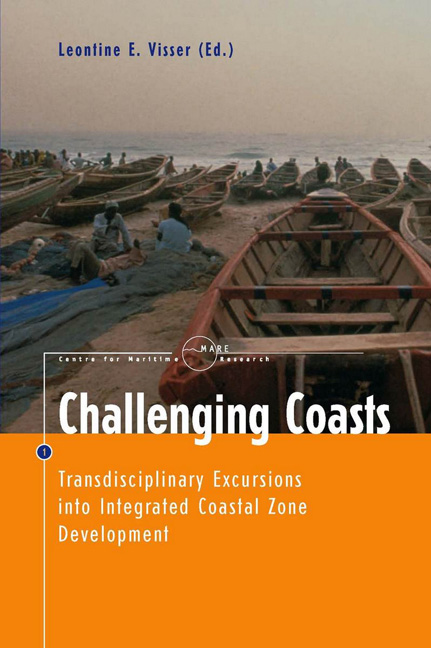Book contents
- Frontmatter
- Series Foreword
- Contents
- Acknowledgments
- 1 Introduction
- 2 Reflections on Transdisciplinarity, Integrated Coastal Development, and Governance
- 3 Biodiversity and the Natural Resource Management of Coral Reefs in Southeast Asia
- 4 A Concerted Approach towards Managing Living Resources in a Marine Protected Area
- 5 ‘Making Do’: Integrating Ecological and Societal Considerations for Marine Conservation in a Situation of Indigenous Resource Tenure
- 6 Basic Principles Underlying Research Projects on the Links between the Ecology and the Uses of Coral Reef Fishes in the Pacific
- 7 The Marine Implementation of the EC Birds and Habitats Directives: the Cases of Shipping and Oil Exploration Compared
- 8 Stakeholder Conflicts and Solutions across Political Scales: the Ibiraquera Lagoon, Brazil
- 9 ‘The Rich Eat Fish and the Poor Eat Pork’: The Decline of the Livelihoods of Handpickers of Aquatic Organisms in North Vietnam
- Index
- List of Contributors
7 - The Marine Implementation of the EC Birds and Habitats Directives: the Cases of Shipping and Oil Exploration Compared
Published online by Cambridge University Press: 28 January 2021
- Frontmatter
- Series Foreword
- Contents
- Acknowledgments
- 1 Introduction
- 2 Reflections on Transdisciplinarity, Integrated Coastal Development, and Governance
- 3 Biodiversity and the Natural Resource Management of Coral Reefs in Southeast Asia
- 4 A Concerted Approach towards Managing Living Resources in a Marine Protected Area
- 5 ‘Making Do’: Integrating Ecological and Societal Considerations for Marine Conservation in a Situation of Indigenous Resource Tenure
- 6 Basic Principles Underlying Research Projects on the Links between the Ecology and the Uses of Coral Reef Fishes in the Pacific
- 7 The Marine Implementation of the EC Birds and Habitats Directives: the Cases of Shipping and Oil Exploration Compared
- 8 Stakeholder Conflicts and Solutions across Political Scales: the Ibiraquera Lagoon, Brazil
- 9 ‘The Rich Eat Fish and the Poor Eat Pork’: The Decline of the Livelihoods of Handpickers of Aquatic Organisms in North Vietnam
- Index
- List of Contributors
Summary
Introduction
This paper focuses on two European Community instruments, the Birds Directive and the Habitats Directive, that, inter alia, provide for the establishment and management of protected areas, including marine protected areas. The paper uses the examples of shipping and oil exploration to illustrate how the international law of the sea does not permit a coastal state to restrict all human activities to the same degree and by the same route. This paper is a follow-up to a previous paper by the author which addressed more generally the source of European Community Member States’ powers under international law to implement the Birds Directive in the marine environment.
Some abbreviations have been adopted in this paper. The European Community is referred to as the ‘EC’. Member States of the European Community are referred to as ‘Member States’. The European Community courts, i.e. the European Court of Justice and the Court of First Instance, are referred to collectively as ‘the Court’. Specific articles of the Birds Directive and the Habitats Directive are referred to as, say, ‘Art 4(4) BD’ or ‘Art 6(3) HD’ respectively. The 1982 United Nations Convention on the Law of the Sea is referred to as ‘the LOSC’, and specific articles of the treaty are referred to as, say, ‘Art 211 LOSC’.
Within the footnotes in this paper, the acronyms ‘OJ’, ‘CMLR’, and ‘ECR’ refer to the following publications respectively: the ‘Official Journal of the European Communities’, the ‘Common Market Law Reports’, and the ‘European Court Reports’. Other abbreviations are explained in the course of the paper.
Within the EC, there are currently fifteen Member States, of which only two have no coastline. Put briefly, the Birds and Habitats Directives place duties on Member States to establish protected sites, both on land and at sea, and to manage human activities in order to meet the sites’ nature conservation objectives. The overall network of sites established under both directives is referred to as ‘Natura 2000’. The directives constitute important legal tools for the protection of marine sites in Member States’ waters.
Geographical Scope of the Directives
Before explaining the precise nature of the duties on Member States in respect of site protection, it may be helpful to have in mind the sea areas to which the Birds and Habitats Directives apply.
- Type
- Chapter
- Information
- Challenging CoastsTransdisciplinary Excursions into Integrated Coastal Zone Development, pp. 159 - 180Publisher: Amsterdam University PressPrint publication year: 2004



